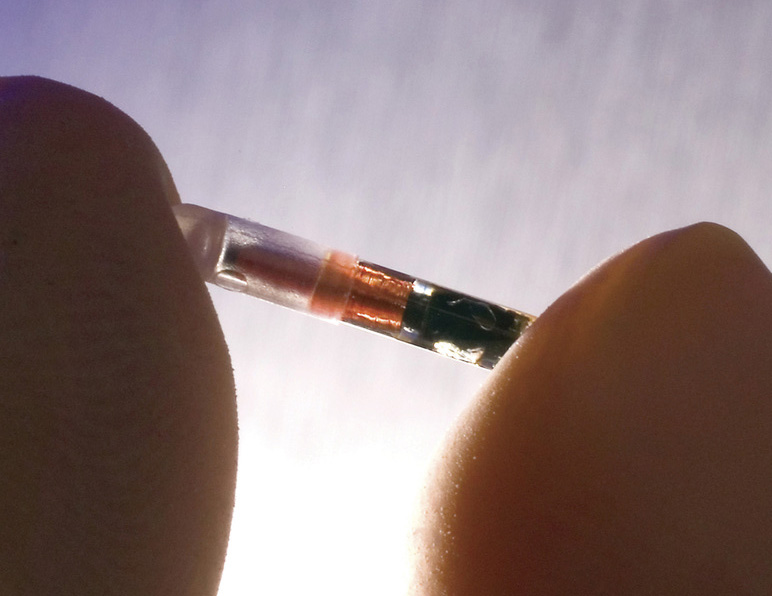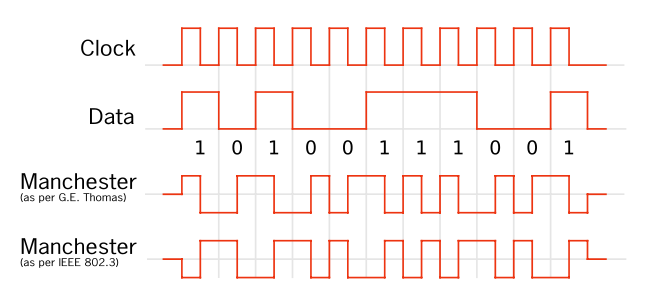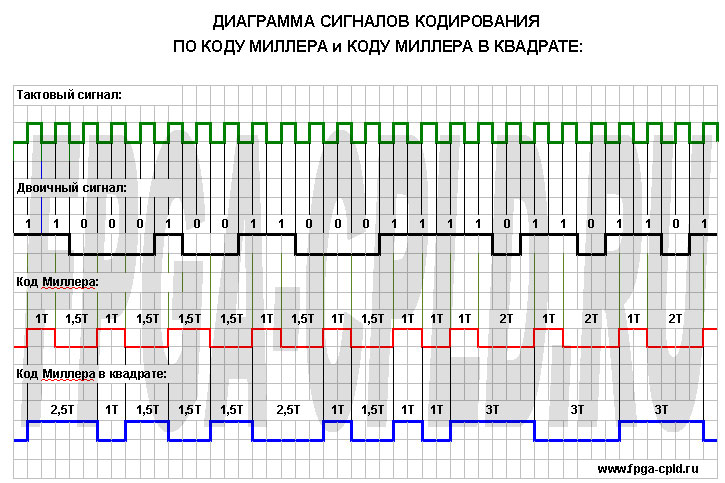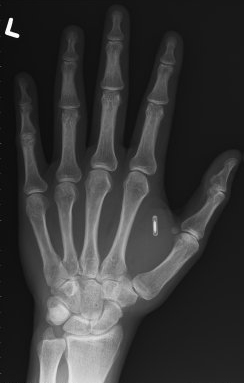Everything you wanted to know about implantable tags, but were afraid to ask
In the footsteps of the previous topic . The comments raised a lot of questions that interested me as well. I will try to answer them.

Answer:
These are RFID tags, which are used in passes, subways, intercoms, etc. Only small, and made of glass, which does not interfere with the body.
Answer:
Not. Not. Not. There is just a microcircuit, and a lot of lots of very thin copper wire acting as an antenna.
')
Answer:
For starters, it would be nice to read Wikipedia .
I will not talk about what chips are AT ALL.
I will talk about those that interest us.
By frequency tags are usually divided into three categories - LF, HF, UHF.
The first (LF, Low frequency) operates at a frequency of 100-150 kHz, usually choose the average - 125 kHz or 134 kHz.
This is the EM-Marin EM410x:

The de facto standard for intercoms with wireless keys. EM410x is the generic name of the family of compatible chips: EM4100, EM4200, TK4100, EM4102, TK28, KB5004HK2 (from Angstrom).
In short: the frequency is 125 kHz, a unique number consisting of 40 bits (do you see the number on the keys? Here it is). The card, however, transmits more - 64 bits, 24 bits is the sync code at the beginning and the checksum at the end. Feedback is not able to, gets into the field - begins to transmit cyclically, and that's it. It is impossible to change the number, it is stitched at the factory.
The range is up to 10 cm. No, it can be more, but you need either a large mark or a large antenna.
At the physical level, the signal is transmitted by the Manchester code :

Those. gaps clock in sync.
The second category, HF, is tags operating at a frequency of 13.56 MHz.
This, for example, is an acquaintance of all NFC , about whose presence in smartphones did not speak only lazy.
And these are the most common Mifare cards and tags in the world, used, for example, in the Moscow metro (specifically, Mifare Classic 1k cards), which are constantly being hacked .
These are also marks in new passports - SmartMX. And many more not so well-known companies, standards, protocols that we are not particularly interesting.
All of these cards comply with ISO 14443 . The distance is up to 20 cm. Unlike the previous card, the standard does not regulate the card capacity - as much as you want, transfer as much as this is already a concern of the protocol and the device. Accordingly, it is possible to change the codes, and to program - complete freedom. Of course, no one guarantees your protocol compatibility with Mifare readers, this is the standard for HF access cards.
The physical layer is also Manchester, or Miller’s code :

Answer:
If you have a constant obsessive desire to scratch your neck about the reader, then yes, this would be an ideal option. For all others, the area between the thumb and forefinger is recommended:

Answer:
Anywhere. As keys to a lock that is impossible to lose or forget, or make a safe that can only be opened with your hand:
For authorization on the computer or in the program. To unlock the smartphone when you take it in hand. As a pass to the laboratory or to work. As an immobilizer in the car (there is also an additional reason to refuse, when your brother will ask your car to drive around the city). Make a gun that shoots only in your hand. Or to stalk believers with the seal of the beast , or supporters of the STOP RFID movement, threatening them with a bare hand:

Answer:
No, under the local. Tag sizes are 2x12mm, although there are more and less:

The procedure is performed with a thick needle, which pierces the skin (everything is done under local anesthesia):
No scalpels, cuts and scars.
Answer:
Do not have to. Unlike the tags used for chipping animals, there is no antimigration coating on the surface of the flask - Parylene-C , on which proteins are very actively adhered.
Because of this, it is enough to make a small incision, 2-3mm, after which to capture and pull out the flask with tweezers.
Answer:
Well, theoretically, yes. If you have strong enough nerves, and have basic medical training, it is quite possible. But it is better to turn to a professional, at least in a tattoo parlor (usually they are engaged not only in tattoos, but also in piercings), or in a private clinic.
Answer:
Little ones. When using a sterile label (it can be sterilized at 90 degrees in an autoclave or in alcohol, also preferably not lower than 90 degrees) and sterile instruments - the risk is minimal. The most dangerous thing that can be - you push (somehow) the needle five to ten centimeters further (I don’t imagine how, the truth is, the length of the needle is definitely not enough) the usual place for installation (marked in blue), and you will get to t. n “Kanavela restricted area” is the neurovascular bundle (marked in red).

Therefore, it is still recommended not to do it yourself, if you are not sure about the result.
Answer:
It is not associated with any systems of the body, so you can do whatever you want.
Label operation is guaranteed in the temperature range of -30; +100, if your body temperature goes beyond these limits - the safety of the chip will worry you last.
It is very difficult to break it, if you experience a blow of sufficient strength to destroy the flask, you will have to go into a trampoline to get your arm sewn back, and only then be interested in the fate of the chip. I, of course, exaggerate, but you really can’t break it in any way, doing your usual business.
Answer:
Permanent magnets do not affect it at all - there is nothing there that can magnetize.
As for the electromagnetic fields, the developers took care of this - the microcircuit does not lose its functionality, being in the fields normal for an apartment or the production of tension. The microwave can put the tag out of action, but you won't do it with your hand, right?
The only consequence of x-rays or computed tomography is the doctor's surprise:

They will also find a MRI capsule, but it will not affect it in any way - tomographs use frequencies of 30-130 MHz that are too far from the resonant frequency of the coil to excite a current sufficient for it to work, and especially for failure. From her hand, too, does not vomit, this is the speculation of the writers. True, there will be slight interference in the area of the hand during the examination, and an MRI scan of the hand will not work.
Metal detectors (as well as the framework at airports) will not respond to such a small object.
Anti-theft systems are configured with their own protocol and codes, and will not accept tags of other standards. And besides, the store absolutely will not have video records, as you tried to steal your hand.
Answer:
Yes, EM-Marin is very easy to read or copy. If you need real security, use Mifare, in the maps of this standard there may be a large number of data blocks, each of which can be protected with a separate password.
It should be noted that even to copy EM-Marin, you need to know where you have the chip, and what standard it is - i.e. fully follow you. In this case, copying the keys to the apartment is more simple.
Well, of course, no one bothers you to use a combined authorization system - a label + password, in which the compromise of one of the links does not lead to a compromise of the whole system.
Answer:
Here it is important to buy exactly those tags that you need.
EM-marine standard labels can be found on the Amal-a website, the label separately costs $ 25, and the implantation kit costs another $ 50.
TrossenRobotics is selling similar tags at $ 6.49, but with a $ 50 delivery.
A lot of tags can be found on aliexpress , on request glass rfid. But none of them support the EM-marine standard, only EM4305 is the standard for animal labeling.
And you can subscribe in order not to miss new reviews on the company’s page and in my profile (“subscribe” button)

Question:
What the hell is that?Answer:
These are RFID tags, which are used in passes, subways, intercoms, etc. Only small, and made of glass, which does not interfere with the body.Question:
Is there something poisonous inside? Radioactive? Is there a poison capsule to kill me from a satellite?Answer:
Not. Not. Not. There is just a microcircuit, and a lot of lots of very thin copper wire acting as an antenna.')
Question:
What are the chips?Answer:
For starters, it would be nice to read Wikipedia .I will not talk about what chips are AT ALL.
About the difference between chip and label
In general, strictly speaking, there is a difference. A chip is just a chip without an antenna. A tag is a microcircuit (chip) together with an antenna enclosed in a shell. In practice, you can call both this and that, because chips without an antenna and a shell can only be found at manufacturers.
I will talk about those that interest us.
By frequency tags are usually divided into three categories - LF, HF, UHF.
The first (LF, Low frequency) operates at a frequency of 100-150 kHz, usually choose the average - 125 kHz or 134 kHz.
This is the EM-Marin EM410x:

The de facto standard for intercoms with wireless keys. EM410x is the generic name of the family of compatible chips: EM4100, EM4200, TK4100, EM4102, TK28, KB5004HK2 (from Angstrom).
In short: the frequency is 125 kHz, a unique number consisting of 40 bits (do you see the number on the keys? Here it is). The card, however, transmits more - 64 bits, 24 bits is the sync code at the beginning and the checksum at the end. Feedback is not able to, gets into the field - begins to transmit cyclically, and that's it. It is impossible to change the number, it is stitched at the factory.
The range is up to 10 cm. No, it can be more, but you need either a large mark or a large antenna.
At the physical level, the signal is transmitted by the Manchester code :

Those. gaps clock in sync.
The second category, HF, is tags operating at a frequency of 13.56 MHz.
This, for example, is an acquaintance of all NFC , about whose presence in smartphones did not speak only lazy.
And these are the most common Mifare cards and tags in the world, used, for example, in the Moscow metro (specifically, Mifare Classic 1k cards), which are constantly being hacked .
These are also marks in new passports - SmartMX. And many more not so well-known companies, standards, protocols that we are not particularly interesting.
All of these cards comply with ISO 14443 . The distance is up to 20 cm. Unlike the previous card, the standard does not regulate the card capacity - as much as you want, transfer as much as this is already a concern of the protocol and the device. Accordingly, it is possible to change the codes, and to program - complete freedom. Of course, no one guarantees your protocol compatibility with Mifare readers, this is the standard for HF access cards.
The physical layer is also Manchester, or Miller’s code :

Question:
Where should I insert the chip? In withers, like dogs?Answer:
If you have a constant obsessive desire to scratch your neck about the reader, then yes, this would be an ideal option. For all others, the area between the thumb and forefinger is recommended:
Question:
Where can I use the implanted chip?Answer:
Anywhere. As keys to a lock that is impossible to lose or forget, or make a safe that can only be opened with your hand:For authorization on the computer or in the program. To unlock the smartphone when you take it in hand. As a pass to the laboratory or to work. As an immobilizer in the car (there is also an additional reason to refuse, when your brother will ask your car to drive around the city). Make a gun that shoots only in your hand. Or to stalk believers with the seal of the beast , or supporters of the STOP RFID movement, threatening them with a bare hand:

Question:
How to implant it? Under general anesthesia, perhaps?Answer:
No, under the local. Tag sizes are 2x12mm, although there are more and less:
The procedure is performed with a thick needle, which pierces the skin (everything is done under local anesthesia):
No scalpels, cuts and scars.
Question:
Well, how to pull out? Half-hands need to shred, yes?Answer:
Do not have to. Unlike the tags used for chipping animals, there is no antimigration coating on the surface of the flask - Parylene-C , on which proteins are very actively adhered.Because of this, it is enough to make a small incision, 2-3mm, after which to capture and pull out the flask with tweezers.
Question:
Is it possible to implant it yourself?Answer:
Well, theoretically, yes. If you have strong enough nerves, and have basic medical training, it is quite possible. But it is better to turn to a professional, at least in a tattoo parlor (usually they are engaged not only in tattoos, but also in piercings), or in a private clinic.Question:
What are the risks?Answer:
Little ones. When using a sterile label (it can be sterilized at 90 degrees in an autoclave or in alcohol, also preferably not lower than 90 degrees) and sterile instruments - the risk is minimal. The most dangerous thing that can be - you push (somehow) the needle five to ten centimeters further (I don’t imagine how, the truth is, the length of the needle is definitely not enough) the usual place for installation (marked in blue), and you will get to t. n “Kanavela restricted area” is the neurovascular bundle (marked in red).
Therefore, it is still recommended not to do it yourself, if you are not sure about the result.
Question:
Is it possible to live normally with him? I am familiar with the pacemaker of the heart; he goes neither to the bathhouse, nor to go hunting.Answer:
It is not associated with any systems of the body, so you can do whatever you want.Label operation is guaranteed in the temperature range of -30; +100, if your body temperature goes beyond these limits - the safety of the chip will worry you last.
It is very difficult to break it, if you experience a blow of sufficient strength to destroy the flask, you will have to go into a trampoline to get your arm sewn back, and only then be interested in the fate of the chip. I, of course, exaggerate, but you really can’t break it in any way, doing your usual business.
Question:
What about magnets, radio fields, X-rays, CT and MRI, metal detectors, airport frames and anti-theft systems in stores?Answer:
Permanent magnets do not affect it at all - there is nothing there that can magnetize.As for the electromagnetic fields, the developers took care of this - the microcircuit does not lose its functionality, being in the fields normal for an apartment or the production of tension. The microwave can put the tag out of action, but you won't do it with your hand, right?
The only consequence of x-rays or computed tomography is the doctor's surprise:

They will also find a MRI capsule, but it will not affect it in any way - tomographs use frequencies of 30-130 MHz that are too far from the resonant frequency of the coil to excite a current sufficient for it to work, and especially for failure. From her hand, too, does not vomit, this is the speculation of the writers. True, there will be slight interference in the area of the hand during the examination, and an MRI scan of the hand will not work.
Metal detectors (as well as the framework at airports) will not respond to such a small object.
Anti-theft systems are configured with their own protocol and codes, and will not accept tags of other standards. And besides, the store absolutely will not have video records, as you tried to steal your hand.
Question:
And security? After all, the label can be read by anyone, bringing the scanner closer to your hand.Answer:
Yes, EM-Marin is very easy to read or copy. If you need real security, use Mifare, in the maps of this standard there may be a large number of data blocks, each of which can be protected with a separate password.It should be noted that even to copy EM-Marin, you need to know where you have the chip, and what standard it is - i.e. fully follow you. In this case, copying the keys to the apartment is more simple.
Well, of course, no one bothers you to use a combined authorization system - a label + password, in which the compromise of one of the links does not lead to a compromise of the whole system.
Question:
Where can I buy them?Answer:
Here it is important to buy exactly those tags that you need.EM-marine standard labels can be found on the Amal-a website, the label separately costs $ 25, and the implantation kit costs another $ 50.
TrossenRobotics is selling similar tags at $ 6.49, but with a $ 50 delivery.
A lot of tags can be found on aliexpress , on request glass rfid. But none of them support the EM-marine standard, only EM4305 is the standard for animal labeling.
And you can subscribe in order not to miss new reviews on the company’s page and in my profile (“subscribe” button)
Source: https://habr.com/ru/post/153389/
All Articles